I hadn't planned on posting this recipe because I honestly thought it wouldn't work. Bagels need malt powder, not malted milk powder, right? Malted milk powder has other things in it including dried milk, flour, and baking soda. Would those added ingredients cause problems? No! Malted milk powder is a fantastic addition to these quick bagels. Unlike diastatic malt, it won't affect the rise. But like non-diastatic malt, it will add some flavor.
Jump to Recipe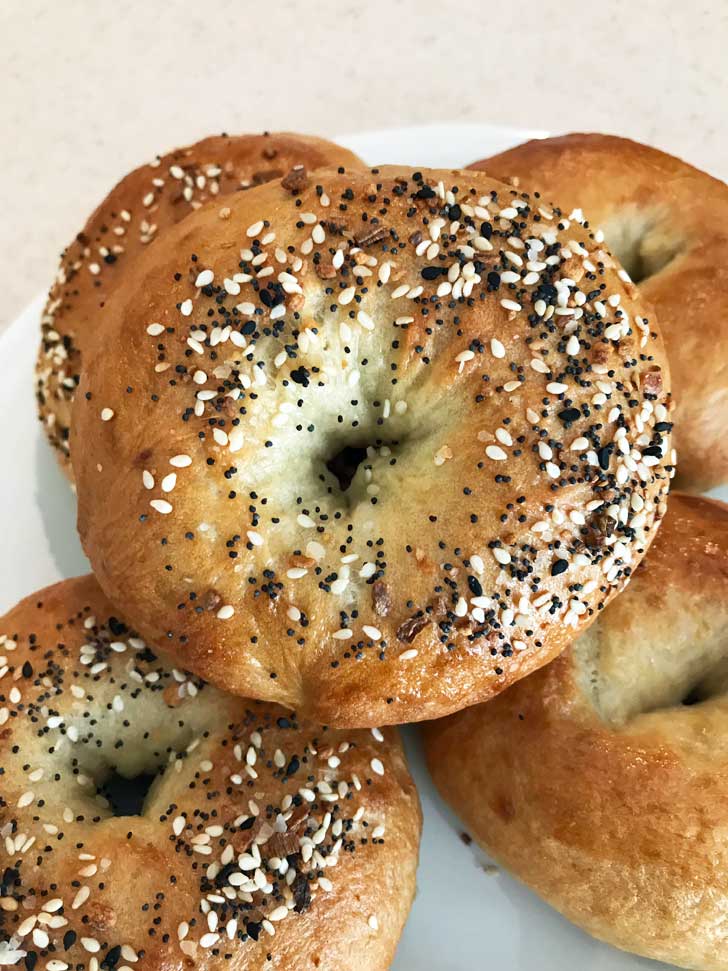
Malted Milk Powder in Bagels
So malted milk powder is not the typical type malt used in bagels, but it's easier to get your hands on than non-diastatic malt powder and has its own set of benefits. Malted milk powder gives you a hit of malt flavor, but also a softer product thanks to the milk powder. Since it's non-diastatic, which just means it doesn't have any active enzymes that affect the yeast, you can use it in the dough without affecting the rise and in the boiling solution for flavor and color.
No Overnight Rise
Some of my other other bagel recipes call for a long ferment, which just means an overnight stint in the refrigerator to develop flavor. Malted Milk Powder Bagels have plenty of flavor and only take about 2 hours to make. So while it's not crucial to bagel recipes, a little malted milk powder in the dough adds some bagel shop flavor that in most cases would be from using one of the other type malts and or a long fermentation. And personally, I like that bit of extra softness from the milk powder. These relatively quick bagels are still plenty chewy.
If you don't have any malted milk powder but still want to make bagels, here's my other go-to bagel recipe *this one* which also can be made from start to finish in about 2 hours.
High Gluten Flour aka Artisan Flour Note
I usually use King Arthur bread flour, but I've learned to keep some high gluten flour around for things like pretzels, baguettes and bagels. This type of flour makes the dough stronger and easier to work with. For instance, when making bagels, you can put a ring of dough around your finger and twirl it like a lasso without it breaking. It adds even more chewiness to Malted Milk Powder Bagels. That said, the bagels made with King Arthur bread flour are also very chewy.
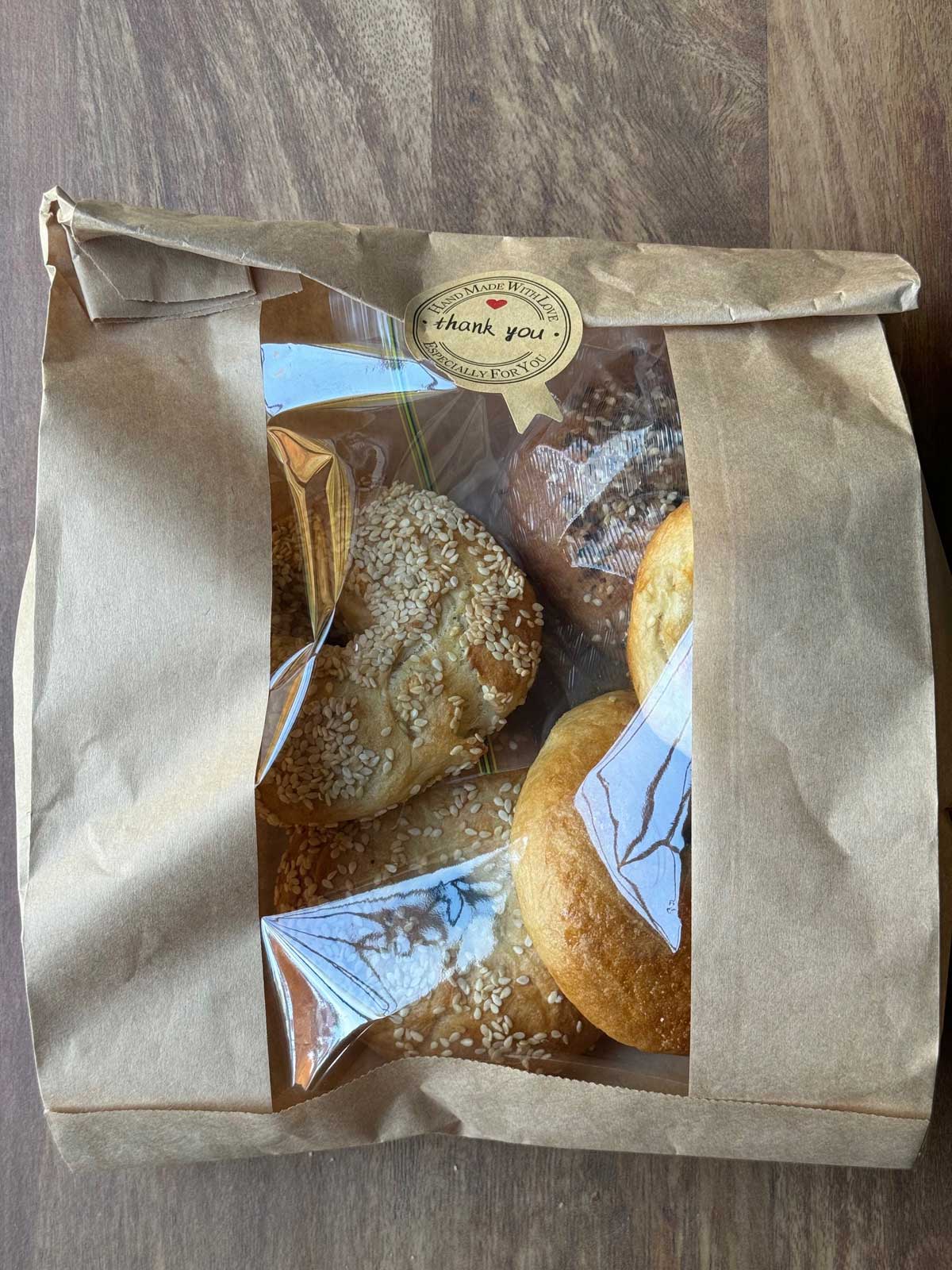
Gifting Your Bagels
This recipe makes 6 good size bagels, but you may find yourself making bagels over and over and want to share them with friends. If so, I found some really cute bread bags on Amazon which are perfect for bagels and probably other breads as well. People really like getting homemade bagels as a gift.
Recipe
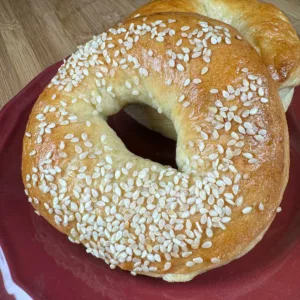
Malted Milk Powder Bagels
Ingredients
- 2 ½ cups bread flour (350 grams)
- 1 ⅛ teaspoon instant yeast
- 2 tablespoons malted milk powder
- 1 tablespoon sugar (12 grams)
- 1 ¼ teaspoons salt
- 1 cup warm water
Boiling Liquid
- 1 ½ quarts water
- 2 tablespoons malted milk powder
- 1 tablespoon sugar or honey
Egg Mixture
- 1 large egg white (you can use whole egg if you like the flavor)
- 1 tablespoon water
Instructions
- To make the dough, weigh out 280 grams of flour. Keep the extra 70 grams nearby. Combine the 280 grams flour with the yeast, malted milk powder, sugar and salt in the bowl of a stand mixer. Stir to mix.
- Add the warm water and stir to make a very soft dough. Put mixing bowl on the stand and begin kneading with the dough hook. At this point the dough will still be very sticky and cling to the side of the bowl. Begin adding reserved 70 grams of flour 2 tablespoons at a time, stopping occasionally to scrape sides of bowl. Dough should start to leave the side of the bowl.
- Continue kneading and adding flour little by little until you have a dough that clears the sides of the bowl and clings to the hook. Knead for about 5 minutes or until smooth and elastic. If you need to use more flour, go ahead. The dough should be smooth, strong and not sticky (but not dry, either).
- Remove dough from hook, cover the mixing bowl and let dough rise for about 40 minutes to 1 hour.
- Preheat the oven to 425 degrees F.
- Line two baking sheets with parchment and grease the parchment lightly with olive oil.
- Gently deflate the dough, and transfer it to a pastry mat. You can put a little flour on the mat if you need it, but if your dough is strong you should be able to get away with as little as possible extra if any. Divide into 6 pieces. Shape each piece into a smooth ball, poke a finger through and twirl the circle around your finger. The other method is to roll the pieces into logs and pinch together the ends.
- Set each shaped bagel on the parchment lined sheet, spacing out the bagels as much as you can. Grease a large piece of plastic wrap, cover the bagels with it and let the bagels sit for only about 15 to 20 minutes while you prepare the water bath. Don't be tempted to let the bagels rise longer, as they will over-proof and fall flat.
- For the water bath: Put the water into a large pot so that it is 3 to 4 inches deep. How much you use will depend on the size and shape of the pot. I use a large stockpot or a 3 quart saucepan, in which case I have to be a little more careful to avoid boil-overs. Since this is a small batch, I don't mind using the smaller saucepan and boiling the bagels 2 at a time in the smaller pot.
- Carefully lift each bagel dough round and put it in the boiling water. Do only as many bagels as will fit (usually about 2) at a time. Boil for 30 seconds. Flip and boil on the other side for 30 seconds. I've found 30 seconds is just about right. The goal is to gelatinize the starch in the outer layer of dough, so was you boil watch for a change in the consistency of the skin.
- Drain with a slotted spatula and set on a wire rack to allow any excess water to drain off.
- Brush bagels with egg white and sprinkle with Everything Bagel seasoning, sesame seeds or nothing.
- Bake in a preheated 425 degree oven for about 20 minutes.
- For even tastier bagels, allow for a 12 to 18 hour rise in the refrigerator.

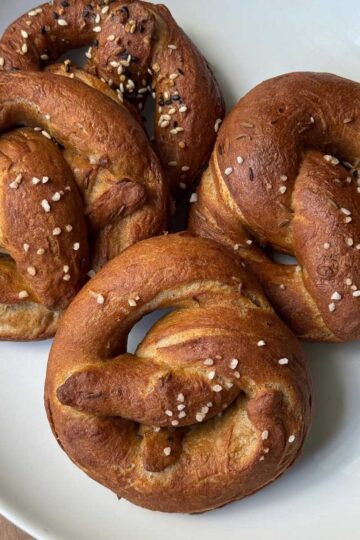
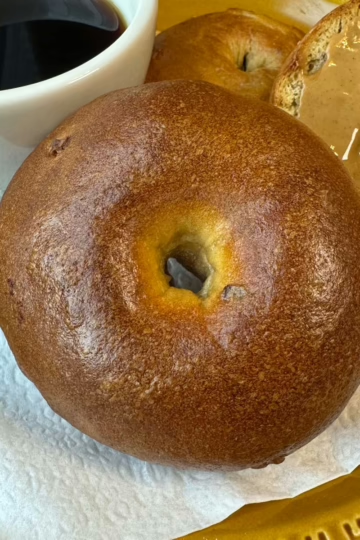
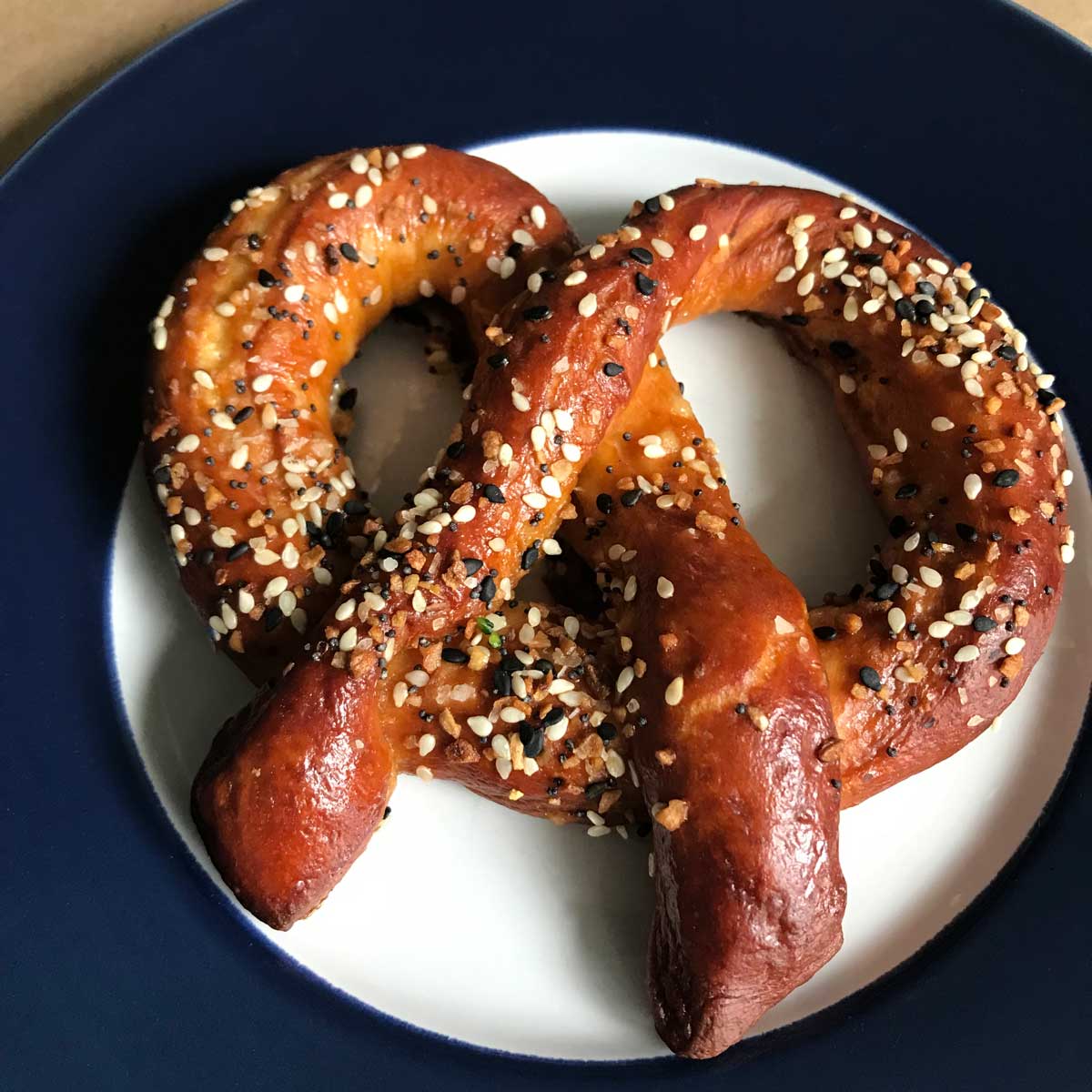
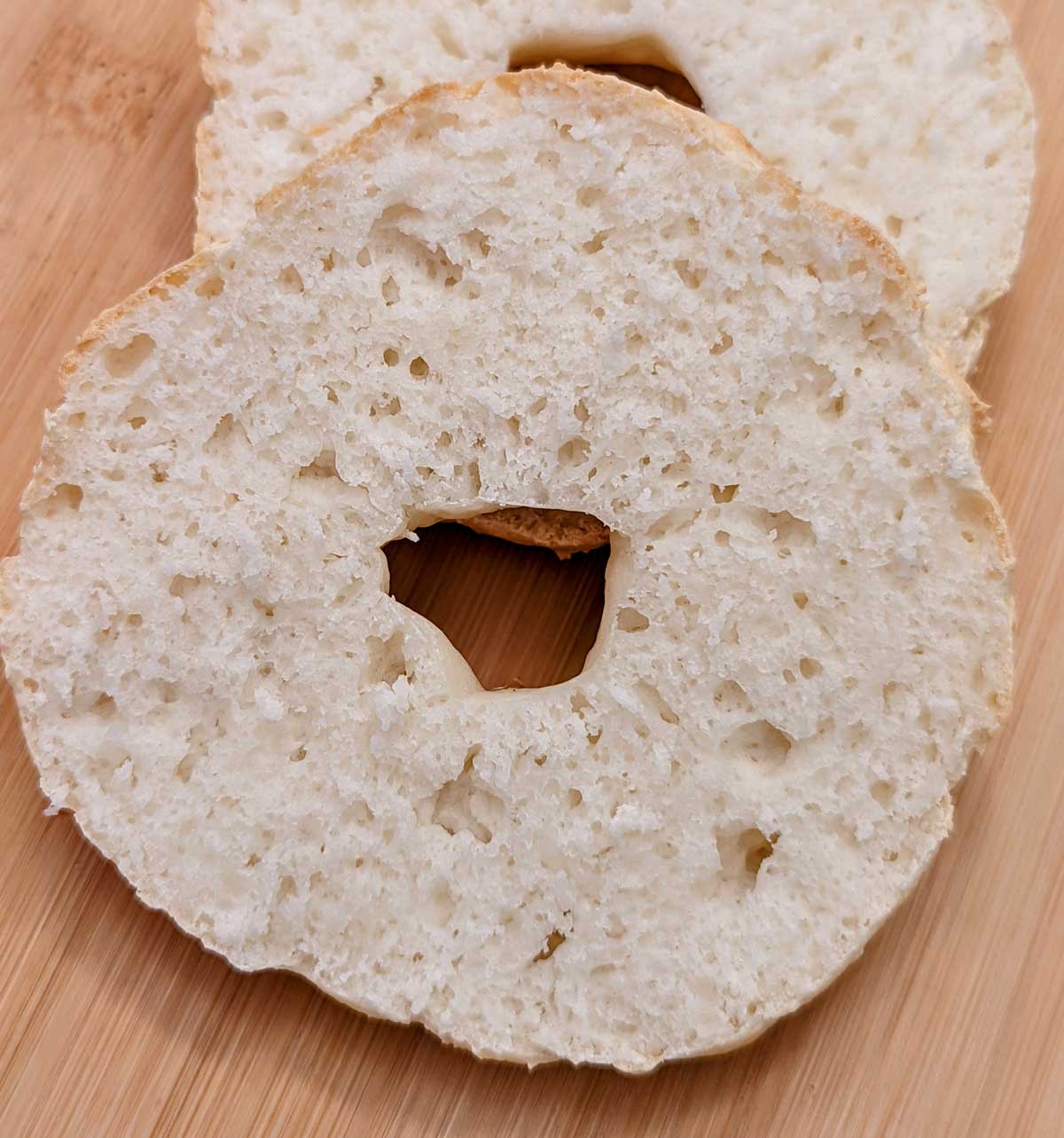
Jen says
I want to try these if I only so that I can twirl dough around my finger like a lasso!